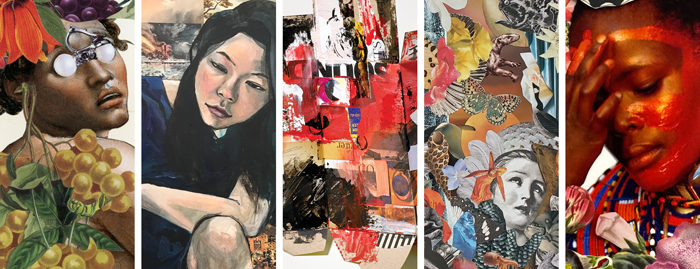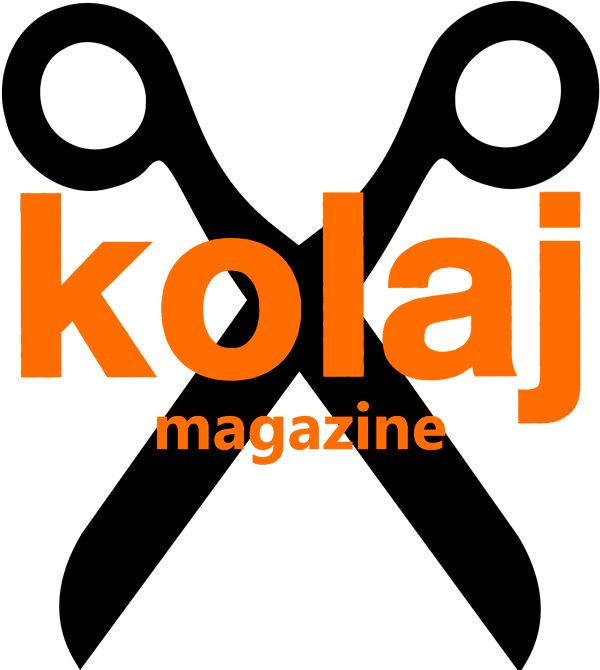
SUBSCRIBE OR ORDER A COPY
In this Issue
Kolaj #28 looks at how collage artists get inspired: how the body decorations of Surma and Mursi Tribes inform Janet Taylor Pickett’s collage; how Koji Nagai uses his first impression of the materials; how Sabine Remy is inspired by an iconic German publisher; how Colleen Cunningham brings pop culture into her work; how Misoo relies on her experience an Asian woman in America; how Rosemary Rae mines the proverbial junk drawer. Articles offer a look at collage operations: Todd Bartel defines “Uncollage”; Clive Knights and Andrea Burgay converse about excavations, projections and depth; Ric Kasini Kadour writes about how history is like tree planting, made in the present for the future. News reports on a Year of Collage in Kranj, Slovenia; collage at Art Miami; a new collage book from Luna Press; and more. Our goal with every issue is that Kolaj Magazine is essential reading for anyone interested in the role of contemporary collage in art, culture, and society. We hope Kolaj #28 gets you informed and get you inspired so you can get to making the best work.
Flashback by Rosemary Rae is on the cover. A discarded box, scrap papers, foil, music sheet, wood type and images with letter pressed letters. “These things could be the items you find in a junk drawer, but here they are, layered and mapped, choreographed on the collage; a cacophony of fragments and styles, somehow coalescing into a pleasant, almost rhythmic, harmonious state.”
In November 2019, Kolaj Magazine announced the creation of Kolaj Institute to support artists, curators, and writers who seek to study, document, & disseminate ideas that deepen our understanding of collage as a medium, a genre, a community, and a 21st century movement. News from the Institute will be a regular feature in the magazine. In Kolaj #28, we report on the first Residencies, Fellowships, & Artist Labs taking place this Spring.
The issue also has an update on World Collage Day (May 9, 2020) and Kolaj Fest New Orleans (July 8-12, 2020).
In other news, KAOS Festival of Contemporary Collage in Kranj, Slovenia announces the Year of Collage and Luna Press publishes Lonely Voyagers by collagist Simon Blake.
In the editorial, Ric Kasini Kadour writes about Tree Planting: “We live in the present, but we exist in the past and the future. I believe this is true for everyone, but it is uniquely true for artists.”
Joan Harrison with Emily Walshe write about Surrealist poet and collagist John Digby and The New Feral Press. “Digby, scalpel in one hand pen in the other, takes his audience for a rollicking and often disturbing romp in the theatre of his imagination.”
“Unequal Twins” takes a look at Sabine Remy’s collaborative artist book project that uses the iconic titles of German publisher Insel-Bücherei.
In the final installment of his four-part series exploring Uncollage, Todd Bartel recalls a Spring 1999 visit to Bo Joseph’s Brooklyn studio where he uttered the word “uncollage” for the first time.
It wasn’t all bananas at Art Miami. Dafna Steinberg reports on a healthy helping of collage at the annual, international art hullabaloo.
Over the next year, Kolaj Magazine is publishing a series of articles that investigates the strategies and approaches artists use to go big, increase the scale of their work, and engage with the larger art world. The first of these articles examine Birmingham, United Kingdom artist Mark Murphy‘s projections and a billboard installation Wardell Milan at DeCordova Sculpture Park and Museum.
In “Emotionality of Branding”, we report how a marketing agency is using collage to express complex research.
A conversation between artists Clive Knights and Andrea Burgay evolved from a discussion planned for Kolaj Fest 2019. Introducing the atypical collage practices of both artists, the dialogue focuses on the use of physical methods of excavation as a metaphor for ideas that drive their work. Part One, in Kolaj #28, features Burgay interviewing Knights. Part Two, in Kolaj #29, will feature Knights interviewing Burgay.

and Janet Taylor Pickett whose Artist Portfolios appear in Kolaj #28.
Artist Portfolios
Janet Taylor Pickett
Pasadena, California, USA
“The Surma and Mursi Tribes use their love of nature for their highly individual body decoration, using the ephemeral flora and fauna of the surrounding environment to juxtapose the traditional (European gaze) and standard of beauty with the ownership of their own Black beauty.”
Koji Nagai
Hiroshima, Japan
“I generate ideas for collages based on my first impression of the materials. I live a simple life and the simple life brings me to the world of collage.”
Colleen Cunningham
Brooklyn, New York, USA
“They are dense compositions with an endless supply of juxtapositions and contrasts. The focal point becomes the beginning of a story.”
Misoo
Shelburne, Vermont, USA
“The Giant Asian Girls are powerful giantesses…benevolently gaze at the chaotic events happening around them; dominating entire villages with their size. They are not rushed, threatened or oppressed.”
Rosemary Rae
San Diego, California, USA
“How Rae finds these secret orders is a mystery, but we are happy that she does.”
If Kolaj #28 looks and feels a little different, that’s because it is. The magazine is now being printed with Paper Machine in New Orleans, Louisiana, USA. Paper Machine is a 5000 square-foot printshop in the Lower 9th Ward that works with artists and writers to manifest their creative projects.
Kolaj Magazine relies our subscribers. Their support of this magazine keeps us going and makes it possible for us to investigate and document collage and to promote a deeper, more complex understanding of the medium and its role in art history and contemporary art.
SUBSCRIBE OR ORDER A COPY
USA & INTERNATIONAL(US dollars) |
CANADA(Canadian dollars) |


